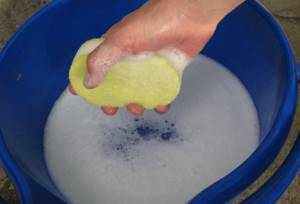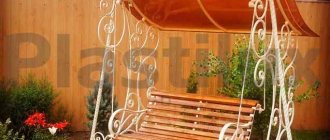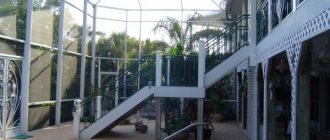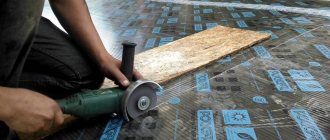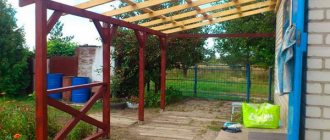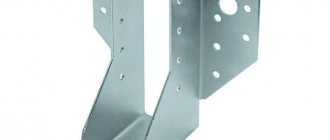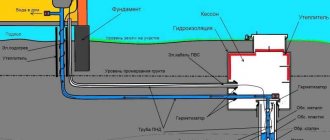Polycarbonate canopies are transparent, durable, lightweight and reliable structures. Choosing this material is not easy, since it is presented in a large assortment on the market. It is important to pay attention to the characteristics and parameters of the material, since the appearance, durability and other indicators of the resulting structure depend on them. Which polycarbonate to choose for a canopy will be discussed in the first part of this material. In the second part of the article we will talk about the classification of polycarbonate canopies.
Advantages and disadvantages
Polycarbonate sheets are an excellent material for constructing canopies. They have a number of advantages. The main ones include:
| Advantages | Flaws |
| Weather resistant. Retain their structure in any weather: rain, snow, wind; | tends to degrade over time under the influence of ultraviolet radiation; |
| high strength index - withstands falling icicles, hail and large amounts of snow; | thermal expansion. It has the property of contracting and expanding when exposed to various temperatures. Corrected using a compression gap; |
| variety of polycarbonate colors for canopies; | abrasiveness. The coating is quite easy to scratch. This is especially true for inclined structures - in winter the snow freezes and when sliding off the canopy it can scratch it; |
| light weight of the material, which facilitates the installation process; | not protected from alkalis and acetone. |
| durability. Throughout the entire period of operation, the material retains its original appearance and properties, but only with proper care; | |
| affordable price. |
You need to carefully consider the process of purchasing sheets and check the product before purchasing, because you may get a low-quality panel.
Types of polycarbonate for canopy
There are three main types of polycarbonate for canopies :
- Monolithic;
- cell phone;
- profiled.
When purchasing, you need to pay attention to the properties of the material. The most important include:
- thickness;
- color;
- plasticity and strength;
- fire resistance;
- light transmittance.
Give preference to trusted manufacturers. You can find a lot of information on the Internet about the quality of the material they offer.
Monolithic polycarbonate canopy
Canopies made of monolithic polycarbonate come in different thicknesses. For the installation of a canopy that is used in the country, an 8 mm single-chamber structure with a distance of 11 mm between the stiffeners and a weight of 1500 grams, a length of 6 m, is better suited.
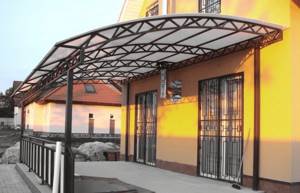
Also, you should not use very thick sheets to build a canopy: this is due to their high cost. They have a high strength rating and can withstand the fall of any heavy objects, so it is good to use them where there is a high probability of falling icicles and other things.
Canopies made of monolithic polycarbonate should not be used for structures with large spans. This is due to the large number of joints that are formed during installation of the material. Dirt and dust quickly accumulate in these areas, which lead to leaks.
Externally, this material resembles glass, but the strength indicator is much higher. Its service life is long, as a rule, it is fifteen years or more. The material is often used in the construction of polycarbonate pool covers.

Cellular polycarbonate canopy
Cellular polycarbonate canopies are no less popular, and they also come in different thicknesses. The material is able to retain heat well, and if we compare it with glass, the latter product is significantly inferior in performance.

This ability is explained by the peculiarities of the structure of the sheets. They are presented in the form of cells, between which there are voids filled with air. The thermal conductivity of the latter is low.
Cellular polycarbonate canopies differ in appearance from others. They are practically opaque. In this regard, their ability to transmit light is at a low level. This property can be considered both a disadvantage and an advantage of the product.
Characteristics of polycarbonate for canopy
The size of the canopy sheet is an important material parameter. It must be taken into account when purchasing, since it determines what kind of design you will get. Moreover, it is important to note that the linear length and width are mainly in the same range. The main difference is the thickness of the polycarbonate.
If we talk about the standard sizes of polycarbonate sheets for a canopy, then:
| Parameter | Cellular | Monolithic |
| Width, m | 2,1 | 2,05 |
| Length, m | 6 and 12 | 3,05 |
This material is found not only in standard sizes, but also in non-standard ones. This is explained by the peculiarities of the structures, which are mounted according to individual drawings. In this way, original and unique structures are obtained.

It is also worth paying attention to the thickness of the polycarbonate for the canopy, weight and minimum bending radius. If the product will be used in bad weather conditions, then it is necessary to choose a material with a good indicator. There is a relationship between the type of structure, thickness and bending radius. Use the data in the table below to calculate the thickness of the polycarbonate for the canopy.
| Type of canopy | Polycarbonate thickness, mm | Minimum bending radius, mm | Weight |
| Visor | 6 | 700 | 1300 |
| Arched | 8 | 1400 | 1500 |
| Inclined single slope on 2-6 supports | 10 | 1750 | 1700 |
| Horizontal with a slope on 6 or more supports | 16 | 2800 | 2700 |
In the interactive form below you can look at carport sizes and average prices depending on the type of structure.
Monolithic polycarbonate
It is worth noting the long service life of monolithic sheets - 15 years, and even more with proper operation. At the same time, they will retain until the last their attractive appearance and properties that are indicated in the table.
| Properties of monolithic polycarbonate | ||||
| Thickness of light-transmitting coating, mm | 8 | 10 | 16 | 20 |
| Bend radius, m | 1,4 | 1,75 | 2,8 | 3,7 |
| Operating temperature, s | -40…+100 | |||
| Light transmission relative to air,%: | ||||
| - Transparent | 82 | 73 | 75 | 64 |
| – Bronze | 35 | |||
| – White opal | 54 | 48 | 48 | 38 |
| Sound insulation, db | 18 | 19 | 21 | 22 |
| Coefficient of linear expansion, mm/(m*s) | 0,065 | |||
| Heat transfer coefficient, W/(m2*s) | 3,4 | 3,1 | 2,3 | 2,0 |
| Thermal conductivity, W/(m*s) | 0,21 | |||
| Flammability group | g2 – moderately flammable | |||
| Flammability group | c1 – low-flammability | |||
| Flame propagation group | rp1 – non-proliferating | |||
Cellular polycarbonate
If we compare monolithic polycarbonate with cellular polycarbonate, the second one is inferior in resistance to mechanical stress. But its “vandal-proof” properties are better. Therefore, this material is good to use when arranging canopies that are located in public places.
| Sheet thickness, mm | 4 | 6 | 8 | 10 |
| Specific gravity g/sq.m | 800 | 1300 | 1500 | 1700 |
| Light transmittance (transparent), % | 82 | 82 | 80 | 76 |
| Light transmittance (color),% | 42 | 35 | 35 | 35 |
| Light transmission (white, matte), % | 32 | 58 | 54 | 48 |
| Thermal conductivity, W/sq.m. | 3,6 | 3,5 | 3,3 | 2,4 |
| Minimum bending radius of sheet, mm | 700 | 1050 | 1400 | 1750 |
| Sound insulation, db | 18 | 18 | 18 | 19 |
| Impact strength | * | 2,1 | 2,25 | 2,32 |
Cellular polycarbonate is easy to use, which allows for quick installation. At the same time, the finished structure will be strong and reliable. Such a canopy will perfectly protect the car and other things from the possible impact of various loads from above: snow, hail, etc.
How to choose a polycarbonate canopy
Types of canopies made of this material are divided into:
- open and closed structures ;
- they can be free-standing or adjacent to different structures and buildings.
Hanging products made of polycarbonate include both large structures and elements of small architectural forms. The design of most canopies meets modern trends and has an attractive appearance.
When choosing polycarbonate, you should focus not only on its color, but also on the thickness and bending radius . Indicators of resistance to snow and wind loads are also important. A major role in choosing suitable material parameters is played by the purpose of the building and its size, as well as the planned spacing of the sheathing.
It should be remembered that a sheet that is too thin requires a small sheathing pitch, otherwise the roof may be deformed. The presence of this threat requires more metal profiles, which, in turn, needs additional supports, which together increases the cost of the canopy.
Excessively thick polycarbonate has low flexibility and causes unreasonable financial expenses on more durable frame components.
Those who are thinking about making a canopy for their car or for other purposes with their own hands should know that such a structure is a simple structure made of polycarbonate sheets, which are mounted on profile metal pipes. That is, you can install the product yourself, subject to certain requirements and the necessary successive stages of work, quickly and efficiently.
Rules for working with polycarbonate
- Do not bend sheets lengthwise during work. This work should only be carried out by the manufacturer, since longitudinal bending contributes to the appearance of cracks and creases in the material. If necessary, you can bend exclusively across the channels when installing polycarbonate on the frame. Carry out this work carefully and carefully, otherwise there is a high probability of damage to the sheets.
- Do not step on the material while preparing it for installation if you do not want cracks and breaks to form.
- You should not remove the film from the material - it provides additional protection for the sheets.
- It is worth cutting polycarbonate for installation with a special grinder with a lot of scars. We first apply markings and slowly cut between the stiffeners.
Now that we have examined in detail the types and characteristics of polycarbonate sheets, we can safely move on to choosing a canopy. More about this in the second part of our material.
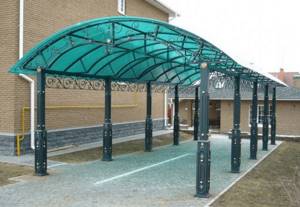
Advantages of polycarbonate house canopies
Among their main advantages are:
- the opportunity to temporarily shelter from rain or sun;
- a way to have a planned picnic with friends, regardless of weather conditions;
- home design improvement.
Before we start designing polycarbonate house canopies, let's look at their types. Typically they are classified by:
- type of construction;
- form;
- type of location.
Each type has its own advantages and disadvantages and is intended for a specific type of site.
Functions of awnings
Without a canopy over the porch, the wall of a dacha or country house looks empty and even a little dull. A beautifully designed entrance immediately creates a feeling of coziness. In addition, standing at the door looking for keys (and it can be very difficult to find them in a woman’s purse) when snow is falling on your head or rain is pouring down is, to put it mildly, not very pleasant. An excellent solution is a polycarbonate house canopy that performs several functions:
- Protection from precipitation and bad weather

A canopy over the front door will make the facade more complete
- Protection from bright sun rays during the hot season
- Decoration of the front entrance
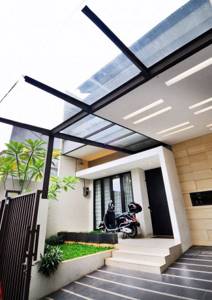
A polycarbonate canopy attached to the house: decorating the front entrance
Advice! Of course, ornate and massive canopies look beautiful, but when choosing a model, you should still take into account the appearance of the house. Only if the styles are fully consistent will the aesthetic function of the canopy manifest itself in full.
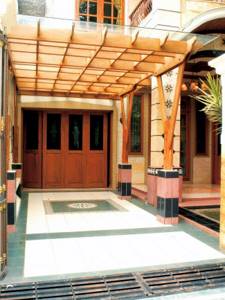
The polycarbonate canopy over the porch must match the overall style of the building
In addition, awnings are installed separately from the house. For example, in order to shelter a car from precipitation or equip a children's sandbox.
Idea! If you have a spacious yard, think about a canopy not only over the porch, but also over the entire area adjacent to the house. The area under the roof will become a real terrace, where on warm days you can have breakfast or drink tea. In addition, bicycles, sleds, skis, etc. can be stored under the shelter.
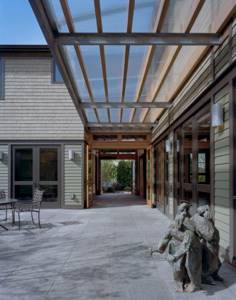
A polycarbonate canopy attached to the house will protect you from the sun's rays

Beautiful carport made of polycarbonate
Canopy options by design type
If we consider the options for canopies by type of construction, we can distinguish the following varieties:
1. Single-pitch. It is a fairly simple design. Moreover, their installation can be called simple. However, it is necessary to calculate the correct angle of inclination in order to ensure rapid snow removal in winter.
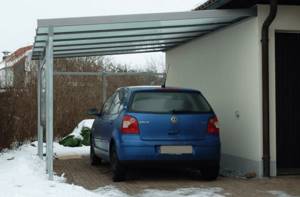
2. Gable. They are most widespread today. They are made at an angle of 35-45°, which allows for rapid snow removal in winter and prevents rainwater from stagnating. Among the gable varieties, one can distinguish those that have a curved or concave slope.

3. Semicircular or arched. With the advent of a new lightweight and plastic material, it became possible to make an original and functional semicircular design. It helps remove snow quickly. When calculating the bending radius, it is necessary to take into account the permissible minimum, which is specified by the material manufacturers.

4. Multi-level. They are a multi-level structure. They can use elements of both pitched and arched types.
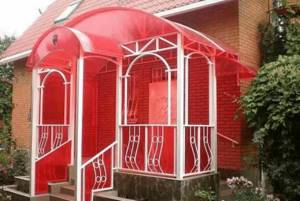
5. Dome. Often used as decorative elements at home. Installation of this type without special preparation will be quite difficult due to its non-standard shape.

6. Concave. This design prevents the accumulation of snow in winter, and also gives the impression of a light, flying structure.
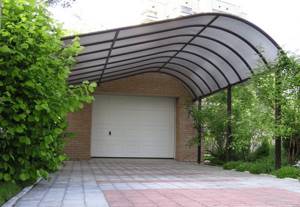
7. Marquise. Recently, polycarbonate has been used quite often for the manufacture of awnings. The awning is a prefabricated structure, which is mainly used for shading windows, terraces, and is also designed to protect from rain and wind. Window-type awnings can be an excellent alternative to blinds or roller blinds. They are attached to the window frame from the outside or mounted in the window opening on top of the glass.
Aluminum pipes are most often used as the material for awnings. Their lightness and strength allow them to easily withstand the weight of the awning, and they are not subject to corrosion.
The reflective effect of sunlight in this case is 80-90%, while blinds can only provide 40%.
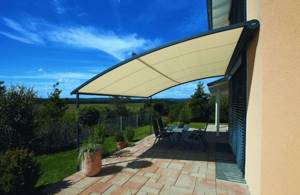
Selecting canopy material
Polycarbonate is a modern material that has several varieties depending on the structure and appearance:
- Cellular - consists of several layers of material, between which there are vertical stiffening ribs. Compared to other types of polycarbonate, cellular polycarbonate is much lighter, bends better and holds its shape, and also has a greater thermal insulation component. This polycarbonate is used to make tent, arched or dome structures, that is, those that require the creation of a complex shape.
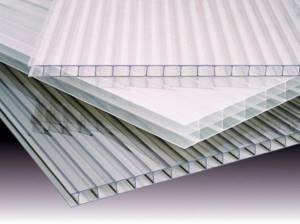
- Profiled - polycarbonate having a surface with wavy or trapezoidal profiles. This material is perfect for those roofs that have a smaller angle of inclination, as it allows water to flow down and not stagnate on the roof.
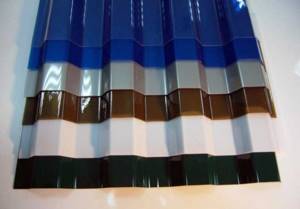
- Monolithic, with a smooth and transparent surface. Externally it resembles glass. This polycarbonate is much more durable than other types, so its use is justified for creating flat canopies that experience heavy snow loads.
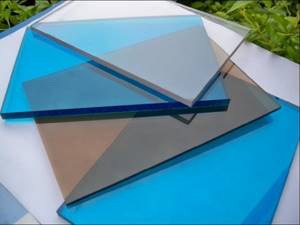
Types of canopies by type of location
If we consider the classification by type of location, we can distinguish the following varieties.
1. Polycarbonate canopies over the steps. The main functional purpose is to protect the porch steps from precipitation, be it rain or snow, and can also act as a decorative element of the entrance group.
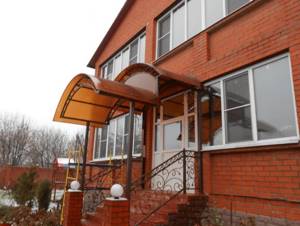
2. A canopy in front of the entrance to the house made of polycarbonate. Most often, its functional purpose is to organize a recreation area. You can install furniture under it, which will allow you to receive guests in the fresh air even in inclement weather. It can serve as a good place for a winter picnic.
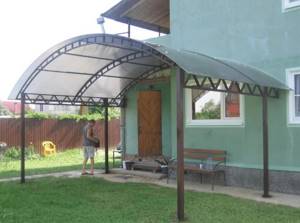
3. A polycarbonate shed near a house is often used as a garage. Although some people make a separate garage, and only then a canopy in front of the garage. In this case, it becomes possible to hide guest cars under it. It can also be used to organize a great time outdoors.

4. Along the house. Several functional meanings can also be distinguished here. It can, first of all, be used to organize a recreation area. You can also store garden tools and other work supplies under it, which will provide them with protection from rain.
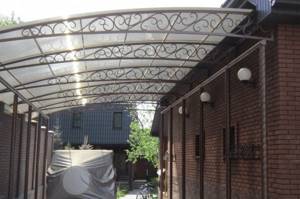
5. Attached. On one side it is attached to the wall, and on the other it is mounted on metal supports (sometimes wood can also be used). The roof is made of polycarbonate. Often it can carry a design load, and is also used for recreation.

6. Polycarbonate canopy over the entrance. They are mostly mounted on one side above the door, and supports are used on the rest. Depending on the size, they can be used simply to protect the entrance area from precipitation. And with larger sizes they can also be used as a garage. This includes the canopy in front of the garage.
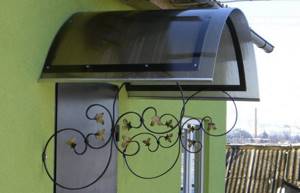
7. Polycarbonate canopy adjacent to the house. Its main purpose is to provide protection from rain and sun. This design is basically a frame supported by posts. The second part of the frame is attached directly to the wall of the building.
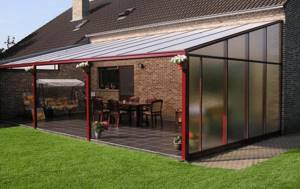
Calculation and preparatory work
To get a durable canopy and frame with minimal costs, you should make the calculations correctly. To do this you need to know the area of the canopy. It is important to consider that the thickness of the sheet is selected so that it can withstand snow in winter. The reliability of the structure mainly depends on the foundation.
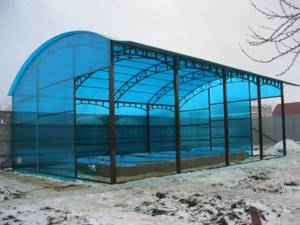
Then the vertical load is installed. Many owners of cottages and country houses are interested in how to make a polycarbonate canopy. You can cope with such a task yourself, without involving specialists in this task.
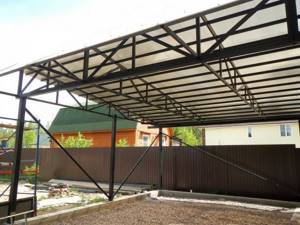
First of all, it is necessary to develop drawings on which all dimensions must be indicated. It is also necessary to decide on the location of the power elements and their quantity. It is necessary to take into account the strength of air currents characteristic of the area where the canopy is installed. If it is mounted for a car, then its dimensions must be larger than the vehicle.
The next step is to determine the thickness of the support elements. You should take care of the tools to perform the work. The amount of materials you need to purchase depends on the project created.

Before installation, care should be taken to arrange the area underneath. The most practical solution would be tiles. Before laying it, mark the places where the supports will be installed, which should be filled with concrete. Subsequent operations are performed after 3 days.

How to properly care for polycarbonate?
This coating requires special care. The quality and service life of the material depends on it. Regular implementation of a number of activities will help with this, and the main one is cleaning it.
Polycarbonate must be cleaned carefully. A sponge and soap solution are perfect for these purposes. You should not use products that contain aggressive substances. They can damage the material.
Even stains that are difficult to remove should be cleaned gently and without the use of sharp objects. It is better to wet them with soapy water and leave them for a while. After this, wash well with a sponge and, if necessary, the procedure can be repeated several times.
